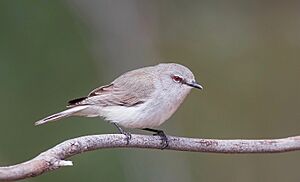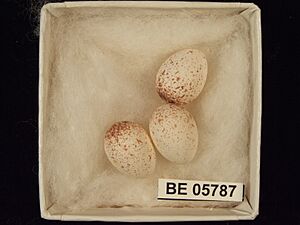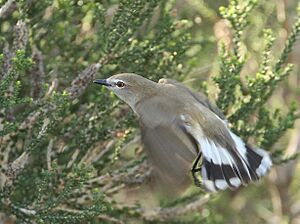Western gerygone facts for kids
Quick facts for kids Western gerygone |
|
|---|---|
 |
|
| Subspecies exsul | |
| Conservation status | |
| Scientific classification | |
| Genus: |
Gerygone
|
| Species: |
fusca
|
| Subspecies | |
|
|
 |
|
| Distribution of the western gerygone: Lighter shaded area represents non-breeding migration. | |
The western gerygone (Gerygone fusca) is a small bird. It is brownish-grey and lives in trees. You can find it in inland and south-west Australia. This bird eats insects and lives in open forests, woodlands, and dry shrublands. It is not currently in danger of extinction. Experts consider it a "Least Concern" species.
Contents
About the Western Gerygone
The western gerygone belongs to the Acanthizidae family. This family includes thornbills and their relatives. It used to be part of the Pardalotidae family.
This bird is a "sister-species" to the mangrove gerygone. This means they are very closely related. Scientists found this out by looking at their bodies and their genes. It is thought that these two species came from a common ancestor. They separated a long time ago due to very dry weather. Now, they live in different places and do not breed with each other.
Many bird experts recognize the name western gerygone. This includes the International Ornithological Congress.
What Does It Look Like?
The western gerygone has plain, brownish-grey feathers on its back. Its wings do not have any special marks. Its belly is whitish. The throat and chest can have some grey.
Its outer tail feathers have clear markings. They have large white patches at the bottom. There is a wide, dark band near the end of the tail. The very tips of the tail feathers are white.
You usually see this bird alone or in pairs. It stays in the middle or upper parts of trees and bushes. You can often find it by its special, ongoing song. It moves very quickly when it is looking for food.
The western gerygone looks like other gerygone birds. But these other birds usually do not live in the same places. You can tell the western gerygone apart by the large white patches on its outer tail feathers.
Where Does It Live?
The western gerygone is the most common gerygone species. It lives only in Australia. There are three types, called subspecies. They have small differences in their feathers. They also live in different areas:
- Subspecies fusca lives in south-west Western Australia.
- Subspecies exsul lives in eastern Australia. This includes Queensland, New South Wales, Victoria, and South Australia. There is also a group on the Eyre Peninsula in South Australia.
- Subspecies mungi lives in central Australia. This includes parts of Western Australia, the Northern Territory, and South Australia.
Sometimes, these birds travel far from their usual homes.
Different gerygone species usually live in separate areas. Or they prefer different types of homes. The western gerygone is the only gerygone in most of inland Australia. So, it does not usually share its home with other gerygones.
There are also two groups of these birds on islands. Both islands are near Perth in Western Australia. The western gerygone arrived on Rottnest Island in the 1950s. It quickly spread across the island. On nearby Garden Island, the bird has been there since people started keeping records.
Life and Habits
Habitat
The western gerygone lives in many kinds of wooded areas. These can be open forests with many eucalyptus trees. They can also be sparse mallee and mulga shrublands. You often find them near rivers and streams. In high areas, they only live below 850 meters.
Movement
Western gerygones move in different ways. Birds in south-western Western Australia are partial migrants. They breed only in the south-west. But some birds move inland or north during winter. Birds in other areas, like the Carpentarian Basin, stay in one place. Birds in the desert move around. They follow the rain.
Foraging
The western gerygone eats insects. It finds food by poking into tree bark. It also picks insects off leaves. Sometimes, it hovers outside leaves to catch insects. It can also fly out from a branch to catch insects in the air. This bird might join groups of other small birds to find food.
Reproduction

Western gerygones usually breed from September to January. But they have been seen breeding from August to March. During courtship, pairs chase each other in fancy ways. They protect their nesting areas during breeding season. If another bird comes too close, they make upset calls. Males show off by fluttering their wings and tail. They tilt their bodies sideways.
The nest is long and oval-shaped. It hangs down from a branch. It has an entrance near the top and a "tail" at the bottom. Both the male and female build the nest.
A female usually lays 2 or 3 eggs. Sometimes, she lays 4. The eggs hatch in 10 to 12 days. Only the female sits on the eggs. The baby birds stay in the nest for 10 to 13 days. Both parents feed the babies. The parents feed the young birds for up to 15 days after they leave the nest.
Song
The western gerygone's song is a series of clear, high-pitched whistles. The tune wanders around. Each note stays at the same pitch. But the pitch changes clearly between notes. The song is not very loud. But it is easy to recognize because it keeps going and has a special sound. When singing, the bird might turn its head with each note.
Songs are quite similar among different groups on the mainland. The birds sing mostly during the breeding season. They are much quieter when they are not breeding.
Song from Rottnest Island
A new and different song has appeared on Rottnest Island. This is where western gerygones settled in the 1950s. Unlike the mainland song, the island song has notes that repeat in a strict tune. In 2003, more than a third of the birds on Rottnest Island sang this new song. Some birds even sang both the new and the old mainland songs.
Scientists are interested in how bird songs change on islands. This helps them understand how new species can form. The new song on Rottnest Island is a good example of a new behavior. It also shows how birds can learn from each other. This happened quickly in a group that was recently separated. Over time, the new song might completely replace the old mainland song on Rottnest Island. If these birds later meet the mainland birds, they might not understand each other's songs. This difference in song can lead to groups of birds becoming separate species.
Status and Conservation
The western gerygone is common in many places. This is especially true in south-west Australia. However, many native plants have been cleared in this area. This has led to fewer western gerygones. It is thought that wild cats do not often hunt these birds.
Inland Australia gets very hot in summer. Heat waves can cause many birds to die suddenly. This can have long-lasting effects on nature. Scientists think that these events will happen more often in the future. This is due to climate change. This is a threat to Australia's inland birds, including some western gerygone groups.
Even though its numbers are going down, the western gerygone is listed as "least concern." This means it is not in immediate danger. It lives in many different habitats. It also lives across a large area. This area includes many protected places, like large national parks.
Gallery







